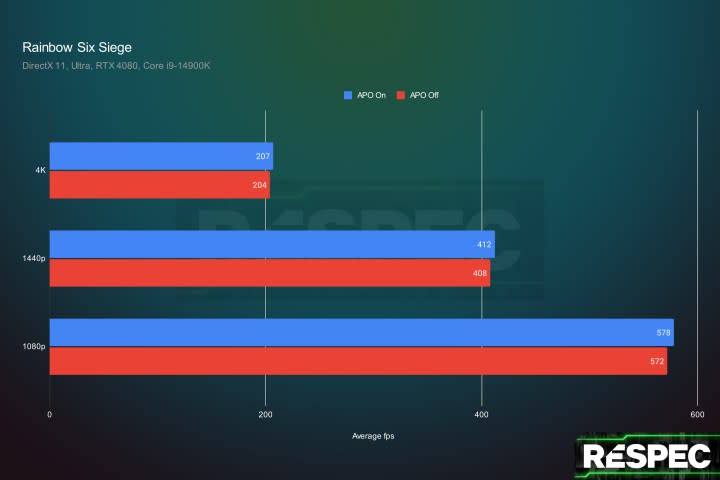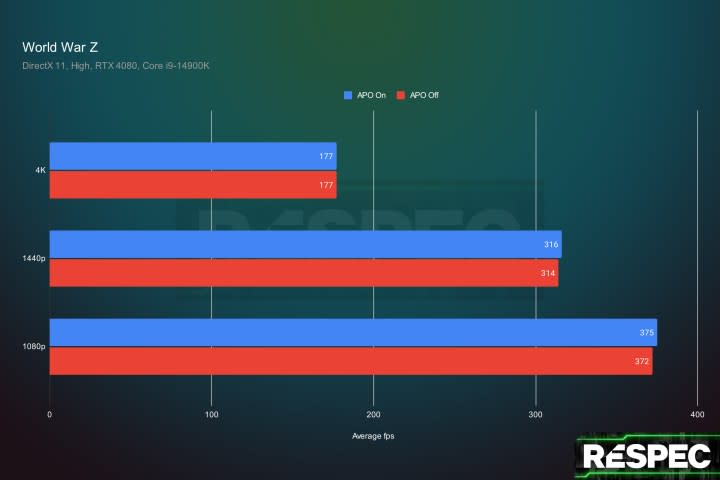Intel’s new CPU feature boosted my performance by 26% — but it still needs work
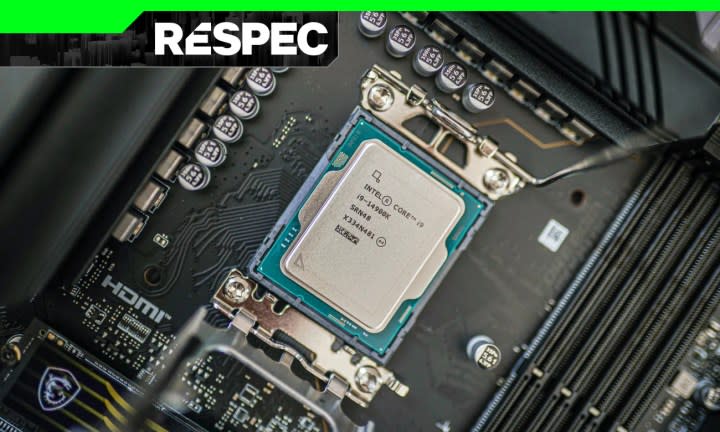
A 26% increase in frame rates from your CPU sounds far-fetched. If that’s not enough to catch the attention of PC gamers, I don’t know is. But trust me — according to my own testing — that’s exactly what Intel’s Application Optimization, or APO, delivers.
What started as a niche feature only supported by Intel’s flagship chip and two games has since been broadened, with unofficial support for older CPUs and a much longer list of titles.
However, your mileage with the feature will vary. Inconsistent performance gains combined with a confusing, frustrating setup process overshadow what APO is capable of. Intel needs to invest a lot of work before it’s worthy of your investment, but as you’ll see, it’s finally beginning to fulfill its ambitious promises.
The sanity check
Diving headfirst into CPU testing on games can be frustrating. Unlike with GPUs, CPU testing is flooded with small performance gains and occasionally inconsistent results. So, instead of running the full suite right off the bat, I like to start with a sanity check.

You can see the result of that sanity check above — a 26% performance improvement in Metro Exodus, which accounts for more than 100 frames of difference. That’s huge. That’s more than a generational improvement, and it’s coming entirely from a software feature.
Context is important here. This was my first test because it created the most constrained CPU environment possible. I’m testing here with an RTX 4080 at 1080p with the Low graphics preset. This creates a CPU bottleneck where we can clearly see what APO is doing to impact performance. The results speak for themselves: APO works.
The basis of APO is Intel’s Dynamic Tuning Technology, or DTT. This is basically a set of algorithms that optimize different areas of performance — think better task scheduling on a laptop to optimize battery life. For APO, DTT optimizes scheduling for peak performance. It ensures that the right work is placed on the right threads, leveraging the mix of performance (P) and efficient (E) cores available on modern Intel CPUs.
Clearly, proper scheduling makes a big difference in performance. The problem for APO is that a lot of games don’t see as clear a benefit, and actually setting up APO is such a hassle that it might not be worth it.
Not always an improvement

I measured a massive 26% jump with APO in Metro Exodus with the Low preset. Bump up to the Ultra preset, though, and APO provides just a 6% jump. That’s still a respectable gain, but it disappears at higher resolutions. APO at 1440p produced just a 2% bump, and there was no difference at 4K. Most of the games I tested fall in that range, too.
World War Z is a great example of that. The game can hit your CPU, but even at 1080p, APO provided less than 1% of a performance bump. That disappeared at higher resolutions, too. Similarly, I saw a bump of 1% in Rainbow Six Siege at 1080p and virtually no performance benefit at 1440p and 4K.
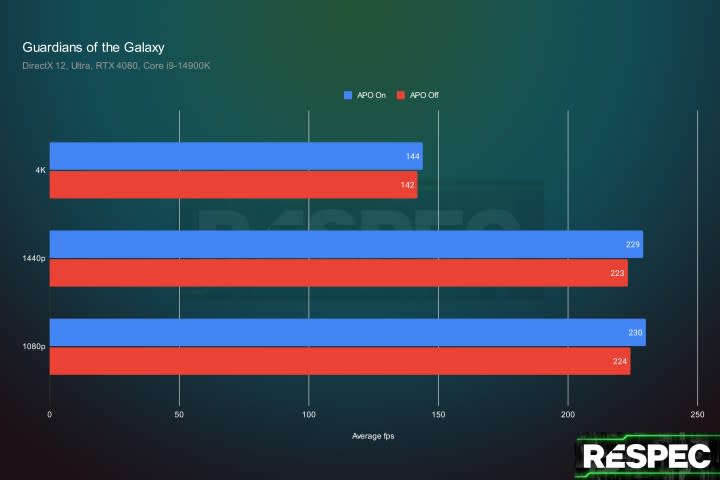
For the sake of completion, you can see Guardians of the Galaxy above. I saw a 3% uplift at 1080p and 1440p, which is impressive, but there wasn’t any significant gain at 4K.
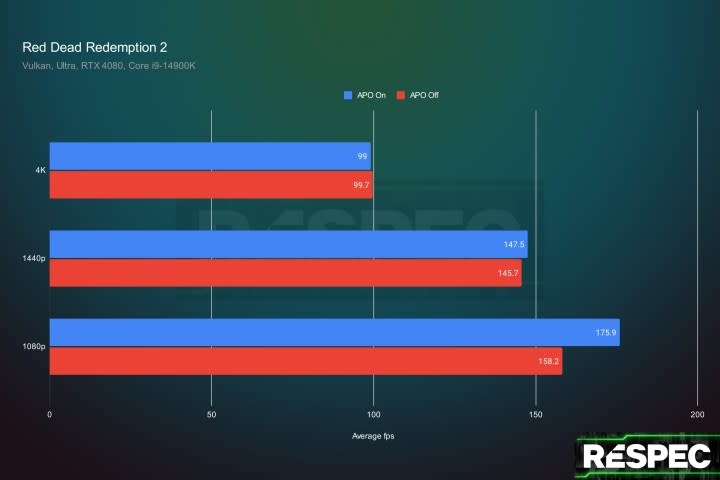
Outside of Metro Exodus, APO looked the most impressive in Red Dead Redemption 2 by far. At 1080p, turning on APO provided an 11% boost in average frame rate. That unsurprisingly diminished at higher resolutions, but it’s great to see such a large performance jump just for enabling a feature.
Clearly there are some applications for APO, but it doesn’t feel like Intel has hit its stride with the feature quite yet. As it stands now, there are only 14 games that have official support for APO. You can experiment with the feature in unsupported games through the Advanced Mode available in the APO application, but Intel warns of “potential performance degradation.”
I’m curious to see where Intel takes APO from here because, clearly, there are scheduling optimizations to improve performance in games, no matter how marginal those improvements may be. Right now, however, it’s hard to recommend a regular customer take the plunge on APO due to its cumbersome setup process.
Ease of use is important
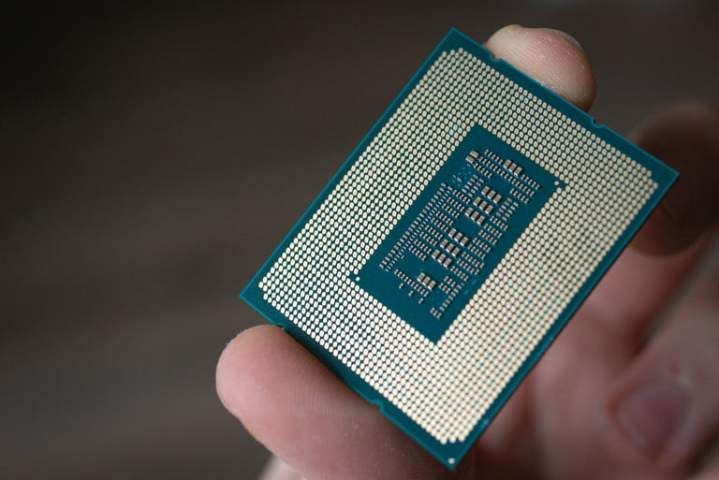
It took me more than a week to get APO working properly. Mind you, I wasn’t focused on getting the feature working the whole time — I have other things to do, you know — but it speaks to the sporadic implementation Intel currently has for the marquee feature of its latest gaming CPUs.
Here’s the general process: You need to have the latest BIOS for your motherboard and a DTT driver. You can find both on your motherboard vendor’s support page. Then, you need to enable DTT in your motherboard’s BIOS before installing the Intel Application Optimization utility through the Microsoft Store. It’s only available through the Microsoft Store, which I could probably write an additional 1,000 words about alone.
That doesn’t sound too bad, but you have to follow this process specifically. If you install the app and then install the DTT drivers, for example, you’ll get an error. I ran into that a few times.
The big issue with APO right now, however, is the reliance on motherboard vendors. When Intel released its latest update, motherboard vendors didn’t have a new DTT driver available for a few days. Despite that, Intel pushed an update to the APO application on the Microsoft Store. The result was that users had their application automatically updated without a proper driver, blocking them from using APO, even if they had already set it up.
A promising start
Intel needs to work on APO a lot before it’s a feature that can sell a new generation of processors, especially after the fiasco with chips like the Core i9-14900K. If users need a new version of the app, a new driver that they have to wait on, and some BIOS setup to get APO working every time new games are added, I don’t see how APO can be successful in the future.
These are growing pains, though. APO needs some work, particularly in getting the feature working easily on Intel systems, but it holds a lot of promise. Hopefully, Intel will continue to build on APO with further game support. In a few months, if we continue to see performance improvements in some games, it might turn into a key reason to pick up an Intel CPU over AMD.
